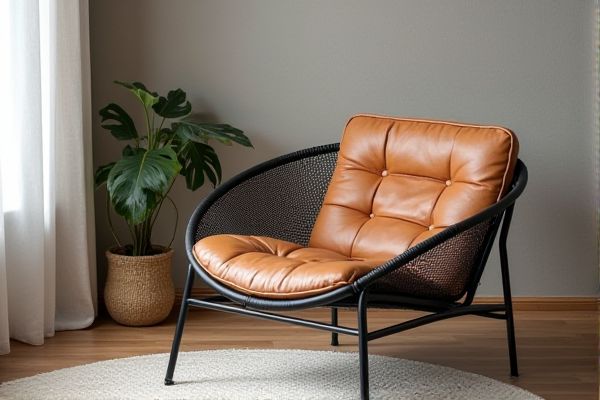
Mesh chairs provide superior breathability and ergonomic support, making them ideal for long hours at your desk, while leather chairs offer a luxurious appearance and durable comfort, suited for executive settings. Discover which chair type best matches your needs and workspace by reading the rest of the article.
Table of Comparison
| Feature | Mesh Chair | Leather Chair |
|---|---|---|
| Material | Breathable mesh fabric | Genuine or synthetic leather |
| Comfort | Airflow promotes cooling, ideal for long use | Soft, cushioned, may retain heat |
| Durability | Resistant to wear, but mesh can sag over time | Highly durable, ages well if maintained |
| Maintenance | Easy to clean, less prone to stains | Requires regular conditioning to prevent cracking |
| Price Range | Affordable to mid-range | Mid-range to premium |
| Aesthetic | Modern, sporty look | Classic, luxurious appearance |
| Best For | Office work, warm climates | Executive offices, formal settings |
Introduction: Understanding Mesh Chairs vs Leather Chairs
Mesh chairs offer superior breathability and ergonomic support, making them ideal for extended desk work and active office environments. Leather chairs provide a luxurious appearance and durability, often preferred for executive settings and formal spaces. Choosing between mesh and leather chairs depends on factors like comfort needs, aesthetic preferences, and office climate.
Ergonomics and Comfort Comparison
Mesh chairs offer superior breathability and flexible support that adapts to your body's contours, enhancing comfort during long hours of sitting. Leather chairs provide a luxurious feel with firm cushioning but may lack the ventilation needed to prevent heat buildup, potentially causing discomfort. Choosing between mesh and leather hinges on your preference for airflow and ergonomic adjustability versus traditional, cushioned support.
Design and Aesthetics Differences
Mesh chairs offer a modern, breathable design with a sleek, minimalistic appearance that complements contemporary office spaces, while leather chairs provide a classic, luxurious aesthetic with rich textures and a polished finish ideal for traditional or executive settings. The transparent quality of mesh material emphasizes functionality and ventilation, contrasting with the solid, smooth surface of leather that conveys elegance and durability. Your choice between mesh and leather chairs will largely depend on the desired ambiance and visual impact in your workspace.
Breathability and Temperature Control
Mesh chairs provide superior breathability and temperature control due to their open-weave fabric that allows air circulation, reducing heat buildup during extended seating. Leather chairs, while offering a luxurious feel, tend to retain heat and may cause discomfort in warmer environments as they trap body heat and restrict airflow. Choosing mesh over leather enhances comfort by maintaining a cooler seating surface and preventing sweat accumulation.
Durability and Longevity
Mesh chairs offer enhanced breathability but may experience wear and tear on the fabric over time, impacting their durability compared to leather chairs. Leather chairs are known for their robust construction and ability to withstand daily use, often improving in appearance with proper maintenance and conditioning. Choosing between mesh and leather ultimately depends on your priorities for comfort and the expected lifespan of your chair in your workspace environment.
Maintenance and Cleaning Requirements
Mesh chairs require minimal maintenance, as their breathable fabric resists stains and can be easily cleaned with mild soap and water, making them ideal for high-traffic office environments. Leather chairs demand more careful upkeep, requiring regular conditioning and specialized leather cleaners to prevent cracking and preserve their luxurious appearance. The durability and ease of cleaning mesh surfaces often outmatch leather in settings where simplicity and hygiene are prioritized.
Cost Analysis: Mesh vs Leather Chairs
Mesh chairs typically offer a more budget-friendly option compared to leather chairs, with prices often ranging from $100 to $300, whereas leather chairs can cost between $300 and $1,200 or more depending on the quality. Mesh chairs provide breathability and durability at a lower cost, making them ideal for extensive use in office environments without sacrificing comfort. Your choice between mesh and leather should factor in not only initial cost but also maintenance expenses, as leather requires regular conditioning to prevent cracking, potentially increasing long-term investment.
Suitability for Home and Office Use
Mesh chairs provide excellent breathability and ergonomic support, making them highly suitable for long hours of office work and home use in warmer climates. Leather chairs offer a sophisticated appearance and durability, fitting well in formal office settings and home offices where style and comfort are prioritized. Both chair types cater to different needs, with mesh chairs excelling in ventilation and lightweight comfort, while leather chairs deliver premium aesthetics and easy maintenance.
Eco-Friendliness and Sustainability
Mesh chairs often outperform leather chairs in eco-friendliness due to their use of recyclable synthetic materials and lower environmental impact during production. Leather chairs typically involve animal agriculture and chemical treatments that contribute to higher carbon emissions and pollution. Choosing a mesh chair can support your commitment to sustainability by reducing resource consumption and promoting recyclable furniture options.
Final Verdict: Choosing the Right Chair for You
Choosing the right chair depends on your priorities: mesh chairs offer superior breathability and ergonomic support, making them ideal for long hours of work, while leather chairs provide a luxurious feel and durability suitable for executive settings. Your decision should weigh factors like comfort preferences, aesthetic appeal, and maintenance ease to ensure the chair matches your workspace environment. Consider how each material aligns with your daily use requirements to optimize both comfort and style.
 homyna.com
homyna.com